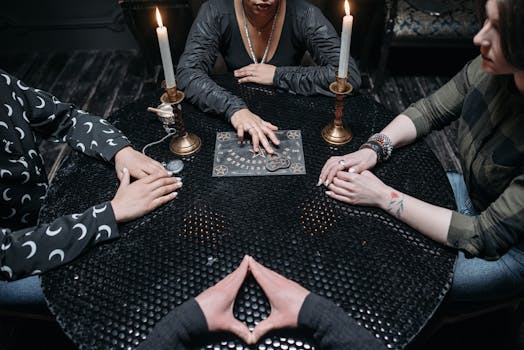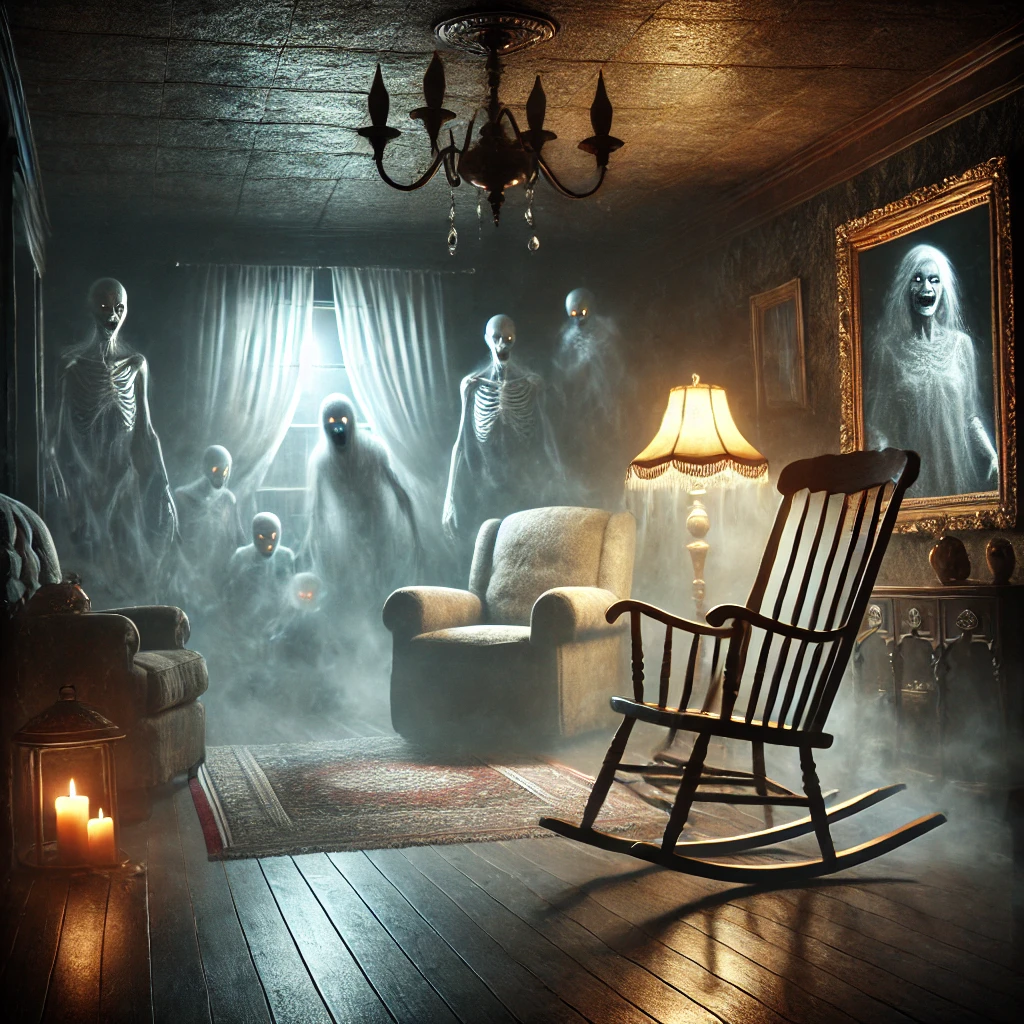Discover the secrets of Djinn spirit powers in Middle Eastern culture. Learn about their origins, types, supernatural abilities, and real encounters from folklore and Islamic belief.
A Djinn spirit is a powerful supernatural being deeply rooted in Middle Eastern culture and Islamic tradition.
The word “Djinn” comes from the Arabic word “jinn,” which means “hidden” or “unseen.”
These spirits are created from smokeless fire and exist in a parallel realm.
Djinn are not ghosts or demons, but unique entities with free will, like humans. They can be good, evil, or neutral depending on their nature.
Djinns were created before humans and live among us, often unnoticed.
Stories of Djinn go back thousands of years and are a major part of Middle Eastern folklore, where they are known to shape-shift, become invisible, and even possess people.
The powers of a Djinn spirit are both fascinating and feared. They have abilities far beyond human capabilities.
A Djinn can travel at incredible speeds, control elements like fire and wind, and influence the thoughts and actions of people.
Some can grant wishes, but always at a price. Others use their powers to protect or punish depending on their moral alignment.
In many tales, Djinn live in remote deserts, caves, or abandoned places. People sometimes summon them through rituals, not always realizing the risks involved.
Djinn spirits remain a strong symbol of mystery and magic in Middle Eastern culture. Their legends continue to inspire stories, spiritual beliefs, and cautionary tales across the world.
Contents
- What Is a Djinn Spirit and Its Powers in Middle Eastern Culture | Ancient Beliefs and Supernatural Abilities Explained
- What Is a Djinn Spirit and Its Powers in Middle Eastern Culture? Explained
- What Is a Djinn Spirit?
- The Different Types of Djinn
- Powers of a Djinn Spirit
- Djinn in Islamic Belief
- Djinn in Folklore and Occult Practices
- Real-Life Encounters with Djinn
- Final Thoughts: The Power and Mystery of Djinn Spirits
- Conclusion: Understanding the Djinn Spirit and Its Powers in Middle Eastern Culture
- FAQ: Djinn Spirits and Their Powers in Middle Eastern Culture
- Related YouTube Video – What Are Djinn?
- Website Sources for Further Reading
- In Closing
- The Paraghosts Blog
What Is a Djinn Spirit and Its Powers in Middle Eastern Culture | Ancient Beliefs and Supernatural Abilities Explained
A Mysterious Force in Ancient Belief
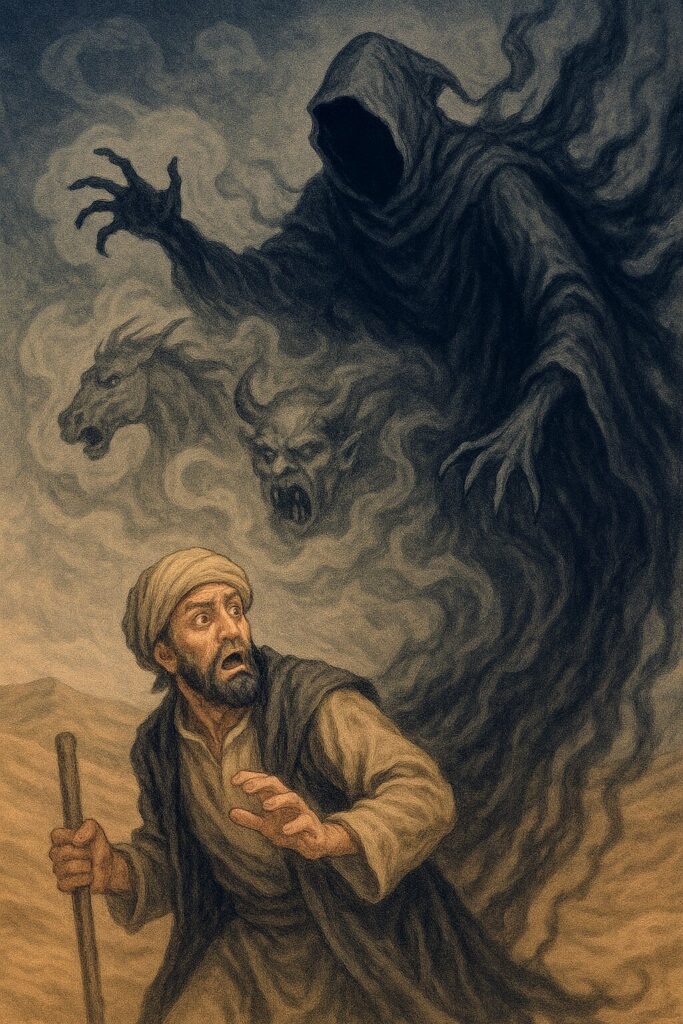
In Middle Eastern culture, the concept of a Djinn spirit is both ancient and deeply respected.
These spirits are part of Islamic tradition and pre-Islamic Arabian folklore. They are said to live in a hidden world that runs parallel to our own.
Djinn spirits are not like ghosts or angels. They are unique beings made from smokeless fire.
People have believed in Djinn for thousands of years, passing down stories filled with mystery, fear, and awe.
Djinn Are Real in Cultural Belief
To many across the Middle East and North Africa, Djinn are not just legends. They are considered real, invisible entities with the power to affect the physical world.
They can influence luck, relationships, mental health, and even cause possessions.
While some Djinn are believed to be helpful or neutral, others are known to be dangerous and malevolent.
Their unpredictable nature makes them both fascinating and feared.
Why Their Powers Still Matter Today
The powers of a Djinn spirit are what set them apart.
They are believed to shape-shift, become invisible, whisper thoughts into people’s minds, and control the natural world.
Some stories say they can grant wishes. Others warn about their tricks and curses.
In modern times, belief in Djinn still influences how people view the supernatural.
Djinn legends continue to shape religious teachings, local customs, and even paranormal investigations.
A Deep Part of Middle Eastern Culture
Understanding what a Djinn spirit is helps reveal the rich spiritual history of the Middle East.
These spirits are more than just mythical creatures. They are woven into daily life, ancient texts, and cultural practices.
Whether through holy scriptures or scary bedtime stories, the power of the Djinn still captures the imagination of believers and skeptics alike.
More Articles
Effective Spiritual Cleansing Rituals to Remove Malevolent Energies
Beginners Guide to Demonology – Understanding Demons and Their Origins
What Is a Djinn Spirit and Its Powers in Middle Eastern Culture? Explained
Unveiling the Mystery of the Djinn Spirit
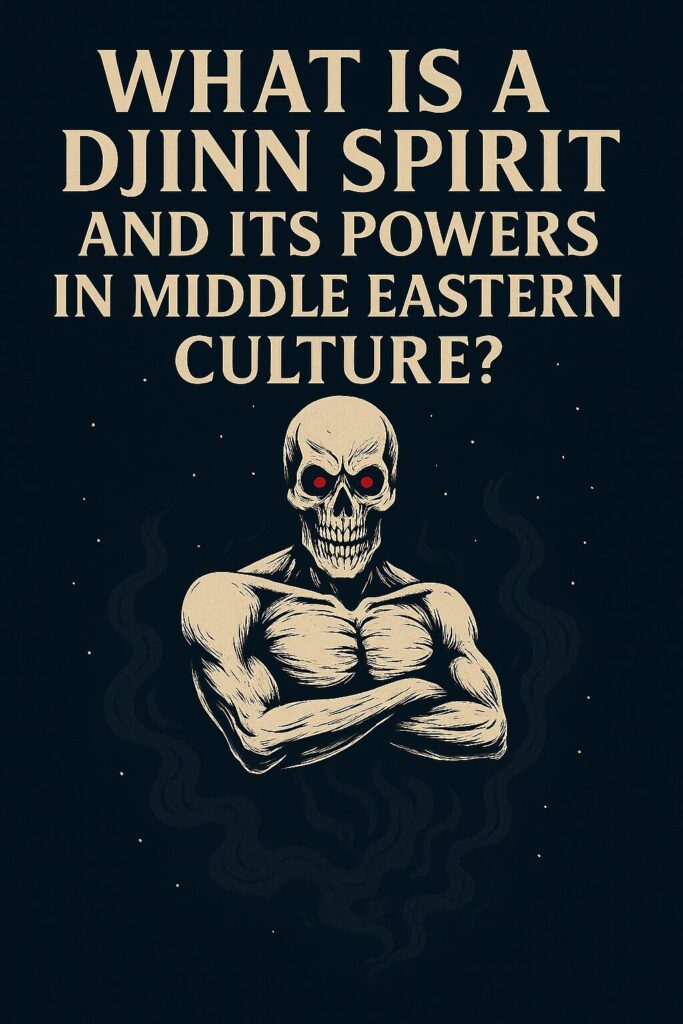
Djinn spirits, also commonly referred to as Jinn or Genies, are among the most enigmatic and feared supernatural entities in Middle Eastern mythology.
Far removed from the cartoonish image of a wish-granting genie in a magic lamp, the Djinn are complex, powerful, and deeply woven into ancient cultural and religious traditions.
Believed to exist in a parallel dimension, these beings are said to influence the world through unseen forces, causing everything from minor disturbances to full-blown possessions.
In both pre-Islamic folklore and Islamic theology, Djinn are regarded as real, sentient creatures with free will, just like humans.
They can choose to be good, evil, or neutral. They live in communities, build families, and some even follow religions.
Throughout history, many people in the Middle East and beyond have reported experiences with Djinn, some terrifying, some enlightening, but all profoundly impactful.
This post breaks down everything you need to know about what a Djinn spirit is, where it comes from, what it can do, and how it still affects people’s lives today.
What Is a Djinn Spirit?
The Origin of Djinn in Middle Eastern Culture
Djinn spirits are said to have existed long before humans walked the Earth.
According to Islamic theology and older Arabian beliefs, Djinn were created from “smokeless fire” by Allah, making them fundamentally different from humans (made from clay) or angels (made from light).
This origin story not only establishes their supernatural foundation but also highlights their dual nature, they are spiritual, yet physical in a different dimension.
The earliest references to Djinn appear in pre-Islamic Arabian mythology, where they were seen as nature spirits or desert entities.
They were blamed for sudden illnesses, misfortune, or bizarre weather events.
These spirits were often worshipped or feared, depending on their behavior and the beliefs of local groups.
After the rise of Islam, the role of Djinn became more clearly defined in religious texts.
The Qur’an openly acknowledges their existence and explains that they, like humans, are accountable to God. Some choose to follow Islam, while others rebel.
This spiritual duality is what makes Djinn so unique. They are neither fully divine nor fully evil. They are not demons in the Christian sense, but they can be demonic in behavior.
Their origin and purpose are steeped in mystery, and their interactions with humans have spawned countless stories across the Middle East.
The Different Types of Djinn
There are many categories of Djinn, each with specific attributes, temperaments, and powers. These distinctions are important in understanding how they behave and what kind of impact they can have on people’s lives.
Marid
The Marid are often seen as the most powerful and proud among the Djinn. They are typically associated with water and are believed to inhabit seas, rivers, and underground lakes.
In mythology, Marid are depicted as large, formidable spirits who are not easily commanded. They are arrogant, often refusing to obey humans unless forced through powerful magic.
Many magical traditions speak of summoning Marid to grant wishes, but this is not easily done. The process often requires long incantations, rare offerings, and binding rituals.
Even then, there’s no guarantee the Marid will comply. They are known for twisting wishes to suit their amusement, leaving the summoner in worse shape than before.
Ifrit
The Ifrit are perhaps the most feared type of Djinn due to their violent and destructive nature.
They are associated with fire, both metaphorically and literally, and are known to dwell in desolate ruins, volcanic areas, or places that have witnessed great suffering.
Ifrit are often depicted as massive winged creatures made of flames or molten rock.
In Islamic texts and folklore, Ifrit are seen as warriors of the Djinn world. They possess enormous strength, a burning hatred for humans, and an insatiable appetite for vengeance.
Some occultists attempt to bind Ifrit using talismans and rituals, but this is considered highly dangerous.
A poorly performed ritual can lead to possession, madness, or even death. They are known to resist control and often look for loopholes in magical contracts.
Shaytan
The term Shaytan refers to Djinn who follow the path of Satan (Iblis). These are malevolent spirits with a specific agenda—to mislead, tempt, and destroy.
Shaytan Djinn are considered the origin of whispers and dark thoughts that enter the human mind. They are skilled in psychological warfare and prefer subtle manipulation over brute force.
In many exorcism cases in the Middle East, the possessing entity is believed to be a Shaytan Djinn.
They use fear, despair, and temptation as tools to break down their victim’s spiritual defenses.
Their ability to cloak themselves and operate invisibly makes them some of the most difficult spirits to detect and combat.
Ghoul (Ghul)
The Ghoul is a terrifying class of Djinn tied closely to death and decay. These spirits are said to haunt graveyards, ruins, and desolate areas.
They feed on the dead and sometimes the living, luring travelers into traps using shape-shifting abilities.
A Ghoul may take on the appearance of a dying person, a lost child, or even a trusted loved one to get close to its victim.
In many folk stories, Ghouls are depicted devouring corpses and bones, spreading disease wherever they roam.
They are less intelligent than Ifrit or Marid but far more primal and animalistic in their hunger. Encountering a Ghoul is often considered a sign of bad luck or an impending death.
Sila and Nasnas
These lesser-known Djinn types are often female and have unique magical talents. Sila are highly intelligent and skilled in manipulation.
They often appear in human form, using beauty and charm to seduce their targets. Stories about Sila often involve betrayal, broken promises, and curses.
Nasnas, on the other hand, are malformed half-Djinn beings. They are said to hop on one leg and speak in garbled tongues.
Despite their physical deformities, they are still dangerous due to their unpredictability.
In folklore, encountering a Nasnas is considered a bad omen, signaling spiritual imbalance or curse.
Powers of a Djinn Spirit
Djinn are believed to possess a wide range of supernatural abilities, and their powers vary depending on their type and intent. Here’s a deeper look at what they are capable of:
Shape-Shifting Abilities
Shape-shifting is one of the most frequently reported abilities of Djinn spirits. These entities can assume almost any form, including animals, humans, shadows, or inanimate objects.
They may take the shape of someone the victim knows to build trust or confusion. This ability allows Djinn to hide in plain sight or torment a person psychologically.
In stories passed down across generations, Djinn have appeared as serpents, black dogs, old men, or stunningly beautiful women.
Their forms often hold symbolic meaning tied to their intention.
A Djinn appearing as a dog may signal protection, while one in the shape of a serpent may represent danger or manipulation.
Invisibility and Interdimensional Movement
Djinn are naturally invisible to the human eye. They exist in what many scholars refer to as a “parallel plane” or “unseen dimension” that overlays our own reality.
Their invisibility gives them a major advantage, allowing them to observe, influence, and even attack without being noticed.
Certain spiritual rituals, prayers, or accidents can cause a human to glimpse a Djinn. However, this is considered dangerous, as seeing them may draw their attention.
Once noticed, a Djinn may choose to follow, observe, or interfere with that person’s life.
Mind Manipulation and Illusion Casting
Another deeply feared power is the Djinn’s ability to influence the human mind. They can plant thoughts, cause hallucinations, and manipulate dreams.
These illusions are so realistic that victims often report experiencing full conversations, relationships, or events that never actually occurred.
Sleep paralysis episodes are sometimes attributed to Djinn manipulation. Victims report seeing a shadow figure standing over them, being choked, or hearing their name whispered.
In many cases, these attacks increase over time if not spiritually addressed.
Possession and Control of Humans
Possession by a Djinn is one of the most dangerous and traumatic experiences a person can face.
This occurs when the spirit forcibly takes over a person’s body or mind, often causing personality changes, memory loss, or violent outbursts.
The possessed may speak in different voices, show unnatural strength, or display knowledge they couldn’t have known.
Islamic exorcists (Ruqyah practitioners) perform specific Qur’anic rituals to drive the Djinn out.
However, success depends on the strength of the spirit and the purity of the practitioner. Repeated possessions often suggest a long-term attachment or curse.
Elemental Control
Different types of Djinn are believed to command elemental forces.
For example, Marid control water and may cause floods, drowning, or water illusions.
Ifrit command fire, leading to sudden combustions, house fires, or unexplained burns.
Shaytan Djinn manipulate air and sound, causing disembodied voices, wind gusts, or eerie whispers.
These powers often show up during paranormal encounters and are used either as warnings or direct attacks.
Djinn in Islamic Belief
Djinn in the Qur’an
The Holy Qur’an provides the most structured theological perspective on Djinn spirits.
They are mentioned in over 30 verses, with an entire chapter named after them—Surah Al-Jinn. According to these verses, Djinn were created from smokeless fire before humans were formed from clay.
This distinction establishes them as one of the earliest intelligent creations of God.
One of the most important aspects of the Qur’anic view is that Djinn possess free will. Like humans, they can choose between good and evil.
They are born, they die, and they will be judged on the Day of Judgment for their deeds. This means some Djinn are devout Muslims, while others are disbelievers or outright enemies of faith.
Djinn are also held responsible for spreading mischief and false teachings when they deviate from the path of righteousness.
According to many scholars, Shaytan, also known as Iblis, is not an angel but a Djinn who refused to bow to Adam and was cast out by God.
This reinforces the idea that Djinn have egos, ambitions, and a unique identity separate from angels.
Djinn and Human Interaction in Islam
In Islam, interaction with Djinn is strongly discouraged. While not all Djinn are evil, any form of contact is seen as spiritually dangerous.
The Prophet Muhammad (peace be upon him) warned against invoking or attempting to communicate with them, as it could lead to deceit, possession, or other harmful outcomes.
Islamic spiritual protection revolves around maintaining strong faith, performing regular prayers (Salah), and reciting specific verses from the Qur’an known for spiritual shielding.
The most commonly recited protections include Ayat al-Kursi (Surah Al-Baqarah, 2:255) and the last two verses of Surah Al-Baqarah.
These verses are believed to create a spiritual barrier between the believer and any unseen evil, including malevolent Djinn.
Many Muslim households also recite Surah Al-Falaq and Surah An-Nas before bed. These chapters are known as the “Mu’awwidhatayn” or the verses of seeking refuge.
They are specifically recommended for protection from supernatural harm and spiritual manipulation. Imams and Ruqyah healers use these verses during exorcisms and spiritual cleansings.
While some Djinn are said to live peacefully among humans, hidden and observing, others can become attached or hostile.
This may occur if a human inadvertently harms a Djinn by stepping into their territory (like urinating in a remote area or throwing boiling water without saying a protective phrase).
Such actions are believed to offend Djinn, prompting retaliation in the form of hauntings or possession.
Djinn in Folklore and Occult Practices
Summoning Rituals and Occult Djinn Magic
Throughout history, occultists, sorcerers, and magicians have attempted to summon and bind Djinn spirits.
These practices are especially recorded in grimoires such as the “Kitab al-Ajnas,” “Shams al-Ma’arif,” and other ancient Islamic magic texts.
Summoning a Djinn typically involves complex rituals, specific incantations in Arabic, symbolic offerings, and drawing protective circles filled with sacred geometries and symbols.
The goal of such summoning varies. Some practitioners seek forbidden knowledge, future insight, or magical power.
Others attempt to coerce Djinn into performing tasks, granting wealth, or bringing harm to enemies.
However, these rituals are not only dangerous, they often come with irreversible consequences.
Summoned Djinn may pretend to cooperate only to later trick, harm, or kill their summoner.
In many documented cases, practitioners have gone wild, fallen ill, or died shortly after failed rituals.
Islamic scholars widely condemn these practices.
Attempting to summon or control a Djinn is considered haram (forbidden), as it requires invoking forces outside of God’s permission.
Even those who begin with protective intent often lose control as the Djinn asserts dominance.
Djinn Bound to Objects and Magical Contracts
Many Middle Eastern legends tell of Djinn being trapped inside objects—lamps, rings, jars, boxes, and amulets.
The idea popularized by Western media (like the genie in Aladdin) originates from these old folk tales. However, in traditional stories, such bindings are never simple or safe.
Binding a Djinn often requires dark magical contracts. The process involves enslaving the spirit through a series of rituals, invocations, and sacrificial acts.
Some legends claim that the Djinn agrees to be bound but will always look for a loophole in the contract.
Others say that even if a Djinn is imprisoned, it remains awake, aware, and full of rage, waiting for the chance to escape.
Stories passed down through generations describe bound Djinn that have cursed families, haunted homes, and destroyed lives after being released or mishandled.
Cursed objects in the Middle East are often believed to contain bound Djinn or their sigils, and locals avoid touching or moving them.
Real-Life Encounters with Djinn
Signs of Djinn Activity in the Real World
Many people across the Middle East, North Africa, and South Asia report encounters with Djinn.
These experiences often begin subtly before escalating.
Recognizing the early signs of Djinn activity is important in preventing possession or long-term attachment.
Common signs of Djinn activity include:
- Disembodied Voices or Whispers:
Victims often hear their names being called when no one is around. These voices may sound familiar or distorted. Sometimes the whisper comes from behind, creating intense fear and confusion. - Sudden Nightmares and Sleep Paralysis:
Many encounters begin with recurring nightmares where shadow figures loom over the dreamer. Victims may wake up paralyzed, unable to speak or breathe, feeling a weight on their chest—an experience often attributed to Djinn pressing down on them. - Cold Spots or Sudden Temperature Drops:
Rooms that suddenly go cold without explanation are common in Djinn hauntings. Unlike ghosts, Djinn bring an unnatural chill that can be felt physically and emotionally, often accompanied by dread. - Animal Behavior Changes:
Cats and dogs may act erratically, staring at unseen corners or growling at empty rooms. In Islam, dogs are believed to sense Djinn and will often bark when one is near. - Shadow Figures and Peripheral Movement:
Victims report seeing fast-moving shadows or dark humanoid shapes from the corner of their eyes. These figures vanish when directly looked at, intensifying fear and psychological instability.
Documented Encounters and Exorcisms
Across the Islamic world, there are thousands of documented cases of Djinn possession.
These stories are often handled within the community by respected Imams, Sheikhs, or Ruqyah experts who specialize in spiritual healing.
During exorcisms, the victim may scream, convulse, speak in tongues, or reveal hidden information.
Some recite the Qur’an uncontrollably or display supernatural strength.
Ruqyah involves reading protective verses, using blessed water or oil, and confronting the Djinn verbally until it leaves.
Some real-life cases have even been recorded and shared on social media, sparking global fascination.
While skeptics may dismiss these events, believers argue that the consistency of symptoms and the cultural specificity of responses indicate something beyond psychology.
Final Thoughts: The Power and Mystery of Djinn Spirits
Djinn spirits continue to fascinate, terrify, and mystify believers across the globe.
Their origins reach deep into Middle Eastern tradition, surviving centuries of oral storytelling, religious doctrine, and spiritual encounters.
Whether seen as ancient beings of fire, cunning shape-shifters, or powerful spiritual forces, the Djinn occupy a unique space between myth and reality.
Understanding the Djinn means acknowledging both their power and complexity.
They are not simple monsters or ghosts. They are intelligent, emotional, and deeply integrated into the supernatural fabric of the Islamic world.
Their abilities range from subtle influence to full possession, making them some of the most dangerous spirits ever documented.
For those seeking to explore the paranormal, Djinn serve as a compelling reminder that not all spirits are harmless.
Some are ancient. Some are vengeful. And some are watching from just beyond the veil.
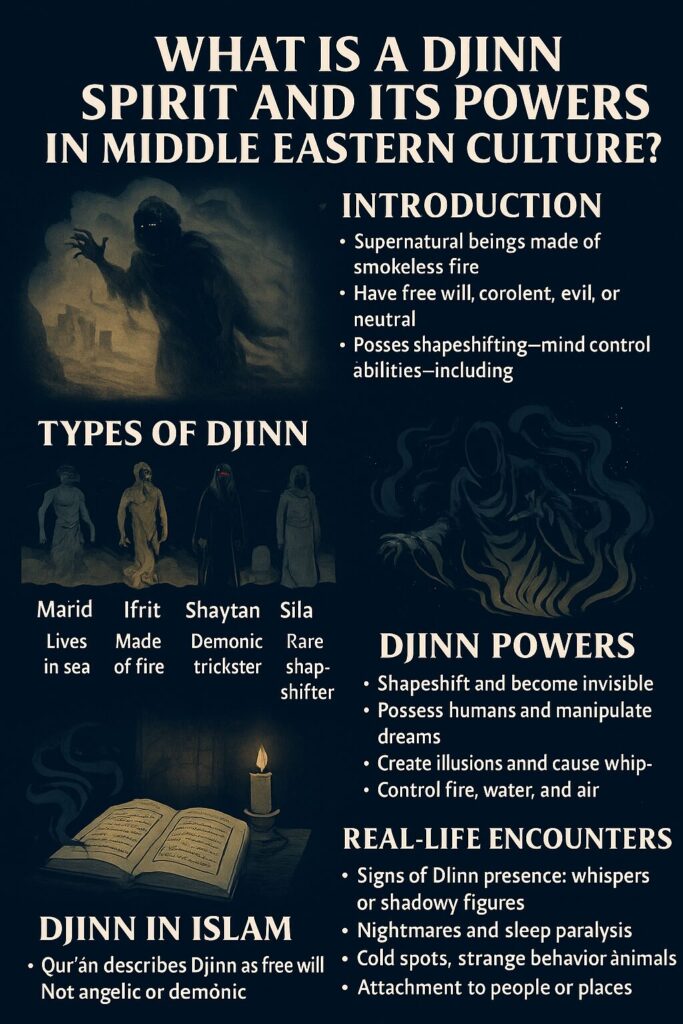
Conclusion: Understanding the Djinn Spirit and Its Powers in Middle Eastern Culture
Djinn spirits are deeply rooted in Middle Eastern culture and belief. They are powerful supernatural beings created from smokeless fire.
Unlike angels or demons, Djinn have free will. They can choose to be good, evil, or somewhere in between.
The powers of a Djinn spirit are vast. They can shape-shift, become invisible, and manipulate the mind.
Djinn are known to possess humans, cast illusions, and control elements like fire and water.
Each type of Djinn—Marid, Ifrit, Shaytan, Ghoul and Sila has unique strengths and abilities. These powers make them both feared and respected across the Islamic world.
Islamic texts confirm that Djinn spirits are real. The Qur’an explains their origin, their free will, and their accountability.
Some Djinn follow Islam. Others rebel. Those who turn evil are considered dangerous and deceptive.
In folklore and occult traditions, Djinn are summoned or bound through magic. These practices often result in curses, hauntings, or possession.
Real-life encounters with Djinn show that these spirits can influence daily life. They whisper in dreams, cause fear, and sometimes attach to people or places.
The truth is that Djinn spirits and their powers are more than just myths. They are central to many spiritual experiences in Middle Eastern culture.
They exist in stories, religion, and unexplained phenomena. Whether you view them as religious beings or paranormal entities, their impact cannot be denied.
Learning about Djinn gives us a better understanding of how the unseen world may affect the physical one.
Respect, caution, and knowledge are key when exploring these topics.
FAQ: Djinn Spirits and Their Powers in Middle Eastern Culture
Below are some of the most frequently asked questions about Djinn spirits, their origins, powers, and roles in Middle Eastern beliefs. Each answer is based on Islamic teachings, folklore, and documented paranormal experiences.
What is a Djinn spirit?
A Djinn spirit is a supernatural being created from smokeless fire. In Islamic belief, Djinn are spiritual creatures with free will. They live in a parallel world that is hidden from humans. Djinn are not ghosts or demons, but they can act in ways that are good, evil, or neutral.
Are Djinn real in Islam?
Yes. Djinn are mentioned many times in the Qur’an and Hadith. Islam teaches that Djinn were created by Allah before humans. They are real beings with families, beliefs, and responsibilities. Like humans, they will be judged by God based on their actions.
What powers do Djinn spirits have?
Djinn spirits are believed to have powerful supernatural abilities.
These include:
- Shape-shifting into animals, humans, or shadows
- Invisibility, allowing them to hide from human sight
- Mind control, including whispering thoughts and causing nightmares
- Possession, where they take over a person’s body or mind
- Elemental control, such as fire, water, and air manipulation
- Illusions, which can confuse or scare people
These powers vary depending on the type of Djinn and their intent.
Are all Djinn evil?
No. Not all Djinn are evil. Islam teaches that Djinn, like humans, have free will. Some Djinn follow Islam and live peacefully. Others choose to rebel and cause harm. Evil Djinn are often referred to as Shaytan Djinn, and they are the ones most often involved in possession, hauntings, or curses.
Can Djinn fall in love with humans?
Yes, according to many folk stories and paranormal reports. Some Djinn have fallen in love with humans. In these stories, the spirit becomes jealous, possessive, and tries to isolate the person. This can lead to haunting behaviors, mood changes, and even supernatural attacks. In Islamic belief, relationships between Djinn and humans are discouraged and dangerous.
How can I protect myself from Djinn?
Protection from Djinn is a serious part of Islamic spiritual practice.
Recommended steps include:
- Praying five times a day
- Reciting Ayat al-Kursi and the last verses of Surah Al-Baqarah
- Reciting Surah Al-Falaq and Surah An-Nas before sleep
- Avoiding known haunted places, cursed objects, and occult practices
- Saying “Bismillah” before entering bathrooms, throwing water, or sleeping
These practices are meant to protect you spiritually and physically from harm.
What should I do if I think a Djinn is in my home?
If you suspect Djinn activity in your home, take spiritual action right away.
Begin by:
- Cleaning the home spiritually with Qur’anic recitations and prayer
- Removing any cursed items, occult symbols, or suspicious objects
- Playing or reading Surah Al-Baqarah regularly in your home
- Seeking help from a qualified Ruqyah healer or Imam if the activity continues
Avoid provoking or confronting the spirit. Islamic guidance recommends patience, prayer, and purity in handling these situations.
Is it dangerous to try and summon a Djinn?
Yes. Summoning a Djinn is extremely dangerous. Most traditions and scholars warn against it. Djinn are cunning and unpredictable. Even if a spirit agrees to help you, it may later seek revenge or trick you. Many people who attempt Djinn summoning suffer long-term spiritual or psychological damage.
Can Djinn be seen by humans?
Djinn are naturally invisible. However, some people report seeing them during spiritual experiences, dreams, or sleep paralysis. Djinn can also reveal themselves if they choose to, often appearing as shadows, animals, or human figures. Certain rituals may open a person’s spiritual senses, but this can be risky and is not advised.
What is the difference between Djinn and ghosts?
Ghosts are believed to be the souls of dead humans. Djinn are not human and were never alive in the human sense. They are a separate creation, with their own world, communities, and rules. While both ghosts and Djinn can haunt places, Djinn are usually stronger, more intelligent, and more manipulative.
Can a Djinn be removed from a person or home?
Yes, through Islamic exorcism (Ruqyah). This involves reciting specific Qur’anic verses, prayers, and using blessed items like Zamzam water or olive oil. A trained Ruqyah practitioner can help drive the Djinn away. Some cases require ongoing sessions, especially if the spirit is deeply attached.
Where Can I Learn More About Spirits and Other Paranormal Topics? Check Out the Paraghosts Blog Below
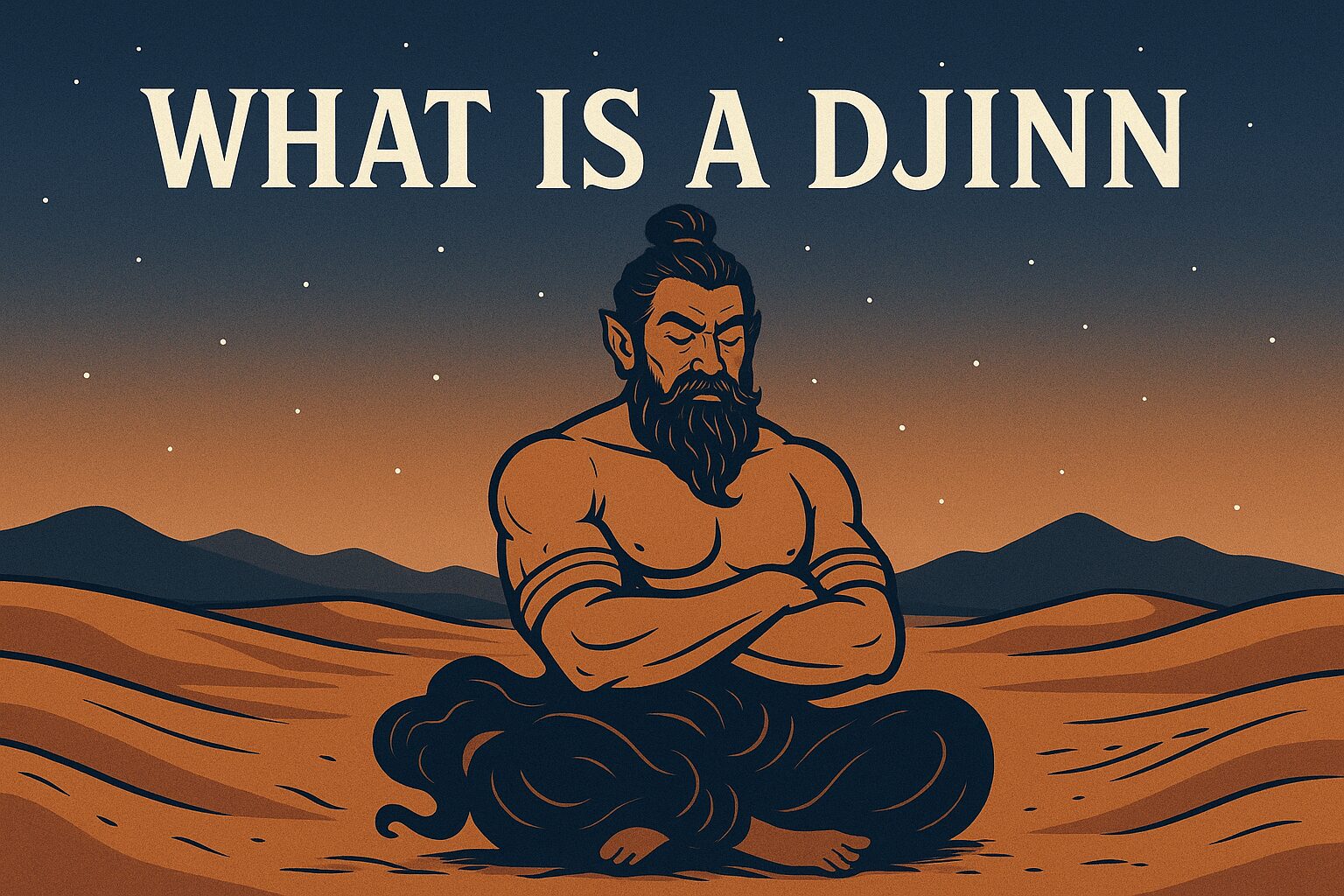
You can explore more articles, videos, stories, blog posts and resources related to the paranormal and supernatural by visiting:
👉 Paraghosts.com — The best place for paranormal content, spiritual insight, and real-life ghost stories and videos.
Related YouTube Video – What Are Djinn?
What Are Jinn? – A Look at the Islamic Spirit Creatures.
an in-depth exploration of Djinn spirits and their powers in Middle Eastern culture, I recommend watching the following YouTube video.
This video provides a comprehensive overview of the origins, types, and abilities of Jinn as understood in Islamic tradition.
You can watch it here:
Website Sources for Further Reading
Demons, Djinns, and Devils of the Medieval Islamic World – Medievalists.net
This scholarly article examines the portrayal of Jinn and other supernatural beings in medieval Islamic texts. It provides historical context and discusses the evolution of beliefs about these entities over time.
Djinn – Supernatural Beings in Islamic Culture (LearnReligions.com)
This article provides an in-depth look into the origins, powers, and spiritual roles of Djinn in Islamic tradition. It covers the types of Djinn, their relationship with humans, their capabilities, and how they are viewed in Middle Eastern folklore and the Quran.
In Closing
Djinn spirits have fascinated people for centuries. Their powers are mysterious and sometimes dangerous.
They are deeply rooted in Middle Eastern culture and Islamic beliefs.
Stories of Djinn continue to appear in modern paranormal reports.
Whether you believe or not, their presence in folklore is powerful.
Keep exploring these ancient beings and their secrets.
For more real paranormal stories and deep insights, visit Paraghosts.com.
The Paraghosts Blog

- How to Record EVP on the Jürgenson Frequency - December 28, 2025
- How to Tell if a House is Haunted or Just Old? - December 26, 2025
- How to Tell if an EVP is a Real Voice or Audio Pareidolia - December 19, 2025

